- Construire / Patrick Bouchain et Loïc Julienne, in Beaumont, Ardèche
- Giuseppe Gabellone in Lyon
- Investigation of the/our Outside – Valence-le-Haut, 24th April 2012
- Michel Aubry, Vercors Regional Nature Park
- Michel Aubry, Pilat Regional Nature Park
- Eulàlia Valldosera in Rochechinard
- Élisabeth Ballet, Pilat Regional Nature Park
- Élisabeth Ballet, Monts d’Ardèche Regional Nature Park
- Susanne Bürner, Vercors Regional Nature Park
- Camille Henrot in Pailherols, Cantal
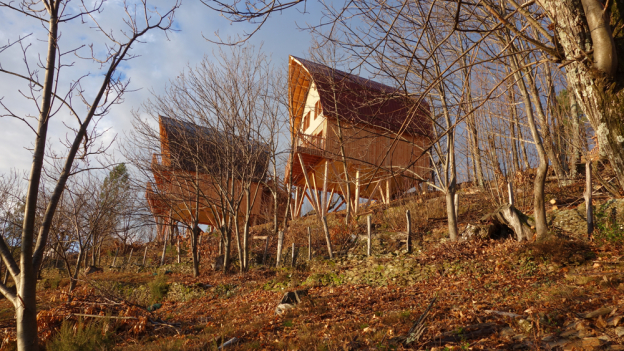
Construire / Patrick Bouchain et Loïc Julienne, in Beaumont, Ardèche
Les Bogues du Blat
Rural Social Housing in the Ardèche Cévennes
The Drobie valley, like the whole of the Ardèche area, has undergone a slow process of agricultural abandonment for more than a century, its steep slopes being too restrictive for mechanized agriculture. This change engendered a major rural exodus that reached its peak in the 1970’s. Recently, the valley has experienced new residential and tourist interest, which has created numerous amenities, not always adapted to the challenges of local development.
The Beaumont commune has embarked on construction and development projects to support sustainable development in the face of growing demand for building land or traditional housing. The Blat hamlet was chosen to accommodate a new residential zone and the commune entrusted an architect with the project of creating a rural social habitat based on the house as a basic unit, all the while giving the opportunity to the hamlet’s social group.
The Construire team’s response made it possible to go further than initial intentions, to open up the commission to their experimental approach and to question the possibility of different ways of building. Entrepeneurs, future residents, architects and artists were consulted throughout the project in order to make the construction a cultural act.
Each house is located astride several restanques[1] and is served by a private road, but parking spaces are grouped together and kept away from the dwellings. The faïsses[2] that are not privately owned may be used for common gardens.
Initial construction consists of an arched frame, its cladding and the layout of the ground floor alone (with living room, bedroom, kitchen and bathroom). After that, two options are possible: simple rental with the possibility, among others, for the tenant to extend the living area into spaces left free; or progressive acquisition of the property as part of a set-up defined with the client.
[1] Restanque is a term used for drystone retaining walls built on steep slopes to establish cultivating terrasses.
[2] Land in strips used for agriculture on steep slopes long deforested.
First batch of 3 houses and 4 dwellings/ lodgings: September 2013
Second batch of 3 houses: January 2017
Patrons: Members of Beaumont’s municipal council and Pascal Waldschmidt, mayor of Beaumont, Jacqueling Nielle and Jean-Remi Durand-Gasselin, mayoral deputies.
Funding: Fondation de France, Rhône-Alpes region, General Council of Ardèche (Cap Territoire), Monts d’Ardèche Regional Nature Park (European Agricultural Fund for Rural Development – Leader.)
+ book link:
The Bogues de Blat experiment was the subject of a publication including the story of the commission and Patrick Bouchain’s study book. Captures éditions, 2018
presentation folder, September 2013 – pdf pdf
crédits photographiques Loïc Julienne et Phoebé Meyer
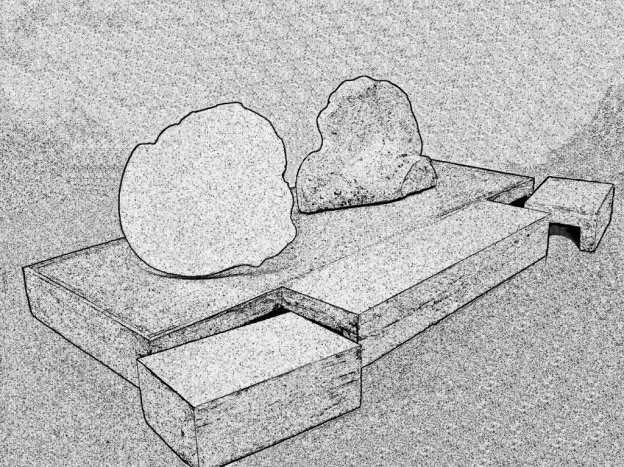
Giuseppe Gabellone in Lyon
Memory Monument
Eager to honour the memory of the under-privileged that they care for on a daily basis, Les Petits frères des Pauvres asked an artist to design a memorial monument in a cemetery. At the time of death, these destitute people are sometimes entitled to a burial plot granted by the city council for a period of six years, but their graves are rarely cared for when they have one. By dedicating a place for collective memory to them, Les Petits frères des Pauvres wanted to signify their belief in the unique value of each life.
Although it is a classic subject in art history, the funeral monument is unusual for artists of Guiseppe Gabellone’s generation. He chose to produce a secular monument that evokes death without resorting to sacred iconography typical of funerary statuary. At the same time he wanted to respect the atmosphere of the place, specific to 19th century French and Italian cemeteries.
The monument consists of two abstract glass modules placed on a white stone plinth that covers two vaults. The plinth is designed to retain rainwater and produce the effect of a mirror. The names of the deceased will be written on the front corner blocks.
The idea is to use the earth as a mold for the glass sculptures, “To make a solid form out of a cavity…as if to capture memory, translate the idea of memory.”
credits: Guiseppe Gabellone
Presentation folder: August 2012 – pdf
Commissioned by Les Petits frères des Pauvres
commission on hold
credits: Guiseppe Gabellone
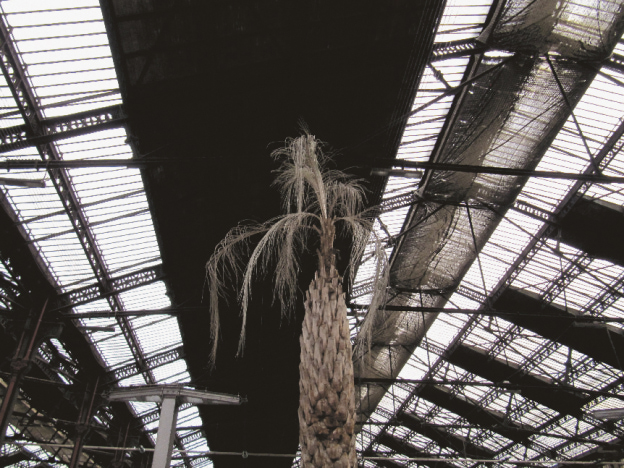
Investigation of the/our Outside – Valence-le-Haut, 24th April 2012
Alejandra Riera with neighbourhood users and residents.
The Fontbarlettes quarter is part of the Valence-le-Haut complex, known as a coherent new city project in the 1960’s, though ultimately the scheme remained unfinished. The patrons, noting a stigmatisation of the neighbourhood, wanted to give the locals a voice, understand how they appropriated the space and their perception of a bigger “outside” likely to invite different interpretation.
Alejandra Riera made several visits to Valence during which she spoke at length with neighbourhood residents, proposed meetings, projected films and organised communal “actions” in different places. With these residents she conceived the filming sessions for her “film-document”. The result is a film and a publication, thought and produced simultaneously, but which function in an autonomous and complementary manner.
The film combines different images such as archives, text images and mises en scène with the residents. In her practice, Alejandre Riera calls “film-documents” a singular manner not only of making films, but of “exceeding” them, that is to say, “thinking of film-documents (…) as outside the scope of film itself, which would constitute a document of its time, adding to its own space the more uncertain space of historical, temporal, affective discontinuities.”
The publication presents itself like an investigative report. It is composed of retrieved pages ¬– the first notes on conversations with the residents – accompanied by footnotes written by Alejandra Riera and image plates with captions inviting new thought for reflection.
Throughout the film and the report, in the dialogue between plates and text, sounds and images, witness accounts, comments and citations, multiple passages become visible or probable, beyond the separation established between the supposed centre and its periphery.
press release, April 2012 – pdf
légende image : Vue partielle, 11 novembre 2008. Gare de Lyon, Paris, palmier en pot, «Butia Yatay, origine : Argentine, Brésil»
Investigation of the/our outside (Valence-le-Haut)) (2007-…) on the 24th April 2012, an image of collective thought on the place in which we live. Alejandra Riera with residents of the Fontbarlettes district.
Twelve Exchanges, “Footnotes” and thirty-nine images and captions
21 x 29.6cm, stitched notebooks, hardback, 352 pages.
800 copies
ISBN 978 2 953391275
25Euros
Captures éditions Captures éditions in partnership with art3, Valence.
commanditaires : des habitant(e)s de Fontbarlettes avec l’association Le MAT
L’Enquête sur le / notre dehors a été initiée dans le cadre de l’action Nouveaux commanditaires proposée par la Fondation de France.
médiation–production : Valérie Cudel / à demeure, en partenariat avec Imagine / Issy-les-Moulineaux et art3 / Valence
soutien : Fondation de France, ministère de la Culture et de la Communication, Centre national des arts plastiques (Image-Mouvement) / DRAC Rhône-Alpes, Région Rhône-Alpes, Département de la Drôme
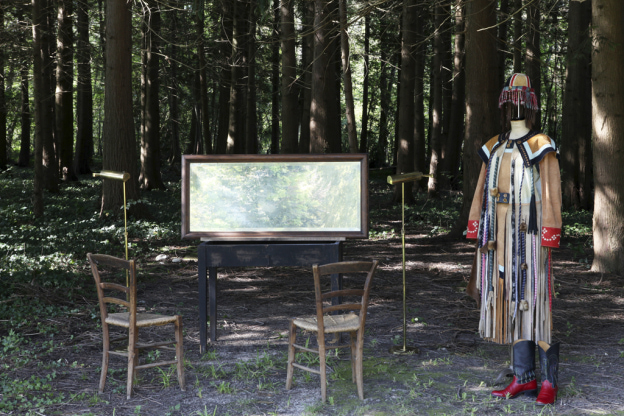
Michel Aubry, Vercors Regional Nature Park
The 72 593th Part of the world
Commissioned within the framework of the inter-parks cooperation project Paysage Industriel (Industrial Landscape): Monts d’Ardèche, Lorraine, Pilat, Vercors
The 72 593th Part of the world
Traditional crafts hold an important place in Royans-Vercors’ history. The production of wooden tableware especially, boomed during the second half of the XXth century, with some fifty companies employing more than six hundred workers. Today only four workshops are in operation. The work requested here must draw on the threads of the past to think of the future and account for the territory’s plural realities.
Straight away, Michel Aubry chooses to decompartmentalize his subject and associate the Vercors project with the one taking place in parallel at the Pilat park. His research is based on three works that evoke the industrial landscape and the relationship with natural resources: Paysage avec travaux de la mine (1544) (Landscape with mine work) by Herri met de Bles, Le Feu (1606) (The Fire) by Jan Breughel the Elder and La Sixième Partie du monde (1927) (A 6th Part of the World) by filmmaker Dziga Vertov.
Michel Aubry’s proposal for the Vercors park is inspired by a sequence from La Sixième Partie du monde showing a Siberian shaman who dances “in a costume laden with symbolic objects, both protection and a conductive jacket linked to natural elements.” He rethinks the shaman’s costume and associates it with the sound tubes designed in the turnery tradition. “Like the shaman, sound connects elements coming from the forest to material objects.”
On the 27th September 2014, Marianne Baillot initiated the work with a choreographic performance.
Today The 72 593th Part of the World is part of the Conservation of the Drôme Department collection and is on permanent display in the municipal council room of Saint-Jean-en-Royans. Other variations of the dance are scheduled for the Vercors region.
Press release, September 2014- pdf
Patrons: Members of the Arbre and Engivane associations and the Vercors Regional Nature Park
Funding: Fondation de France/ New Patrons programme, Vercors Regional Nature Park, European Agricultural Fund for Rural Development: LEADER, Department of Drôme, the town of Saint-Jean-en-Royans
2014
crédits photographiques Phoebé Meyer
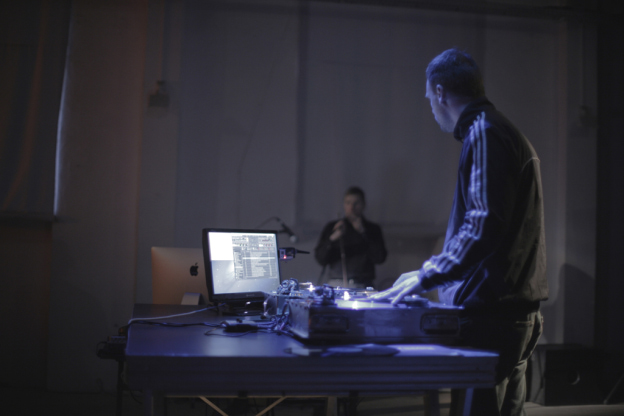
Michel Aubry, Pilat Regional Nature Park
La 213 429th Part of the World
The 213 429th Part of the World is Michel Aubry’s response to a commission given by the Iguerande association and the Pilat Regional Nature Park. It covers an area that retains few architectural traces of its metallurgy activity. All that remains is the notion of a dirty job in contact with black dust. There is a real working culture, however, in the manufacture of the finished object, as well as small companies whose specialization stems from ancient skills in the foundry and precision mechanics and locksmithing industries. How then to restore the place of an industry on the scale of a landscape whose resources have contributed to its development?
Michel Aubry’s proposal echoes the changes in Pilat’s sound environment with the installation of numerous forges, stones used for nailsmithing and subcontracting workshops for the valley’s main industry. Michel Aubry questions this sound footprint by making sound recordings inside the companies. These recordings lead to editioned vinyl records and the manufacture, by the Trouillet company in Saint-Julien-Molin-Molette, of a metal case intended to accommodate an instrument that integrates a pair of turntables and a mixer. It allows you to create compositions from engraved sounds and premixes from the samples.
The records are published in seven examples and assembled in two boxes. The work was performed during a concert performance by hip-hop scratcher Matthieu Crimersmois and dj artists on the 4th July 2014 in the Sainte-Julie factory at Saint-Julien-Molin-Molette.
press release, July 2014 – pdf
Patrons: Éric Perrin, historian and member of the Iguerande association, the Pilat Regional Nature Park
Funding : Fondation de France/ New Patrons programme, Vercors Regional Nature Park, European Agricultural Fund for Rural Development: LEADER 2014
2014
Photographic credits: Marc Domage (2,3) and Emmanuelle Boccou
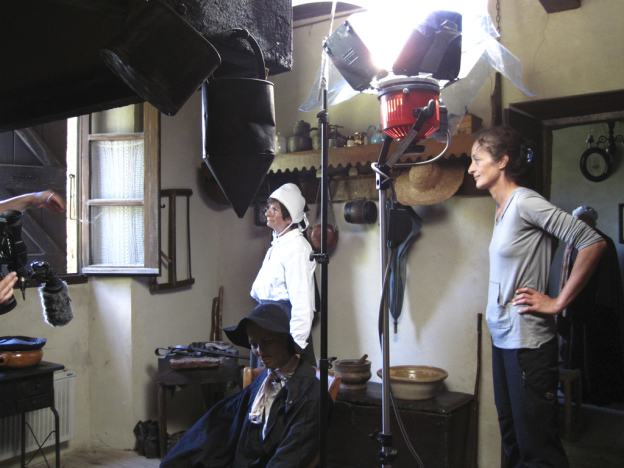
Eulàlia Valldosera in Rochechinard
From 1972 to 1991, the whole village of Rochechinard performed a light show at the foot of its castle. This is the context in which the Rochechinard museum was created – a tangible testimony to the attachment of a population to its history. Named the Royans Memory Museum, its collection is made up of what the locals have given or loaned to it for 40 years. However, the Rochechinard museum is going through a difficult period like most ecomuseums. Its museology could appear outdated and the team has noted a drop in attendance. The association Les amis de la maison de la Mémoire (Friends of the Memory House) approached artist Eulàlia Valldosera to address the issue of transmission – with, in time, the loss of orality that was at the heart of the initial project ¬– establish a double relation, spatial – circulation in the museum, link to the site – and temporal, objects from the past to those of today.
The initial proposition was based on two elements: an author’s film to be projected continuously in the so-called “well” room and the transformation of the museum into a centre for the creation and production of memory. This second step was suspended for political reasons.
The film not only claims to document a project by a group of local people wishing to preserve their local heritage, but also aims to highlight a film object, a current event that reanimates our past, a way to reactivate the potential hidden under layers of forgetfulness and prejudice.
Before the Light articulates different types of registers, ranging from documentary to fiction, and shows the mechanisms the artist used to get there. That is to say, the film crew, their intrusion in the house, the actors’ preparation and their improvised encounters with objects that would be used as props. This film looks at the present at the same time as it recreates the past from stories that members of L’Association créatrice de la maison de la Mémoire (Memory House Creative Association), its guards and interpreters, tell the camera: The anecdotes that they recount during guided tours when the camera is in the audience. This film proposes the medium of film as a form of archive.
The book, Rochechinard, Memory of a House-Museum, published at the end of 2019, is presented as an extension of the commission, an artist’s vision of the transformation of the museum and the state of researchers’ questioning, professionals on the future of these places.
Patrons: Members of the board of directors of Amis de la Maison de la mémoire de Royans association, Alain Derbier, founder of the Rochechinard museum, Mireille Gepponi, Catherine Flament, Jeanne Charve, Josette Derbier, Roland Meunier
Funding: Fondation de France/ New Patrons Programme, former Pays du Royans Community of Communes
Avant la lumière
commanditaires : les membres du conseil d’administration de l’association des Amis de la Maison de la mémoire de Royans, Alain Derbier, fondateur du musée de Rochechinard, Mireille Gepponi, Catherine Flament, Jeanne Charve, Josette Derbier, Roland Meunier
soutien : Fondation de France / action Nouveaux commanditaires, ancienne Communauté de communes du Pays du Royans
2015
crédits : Eulàlia Valldosera
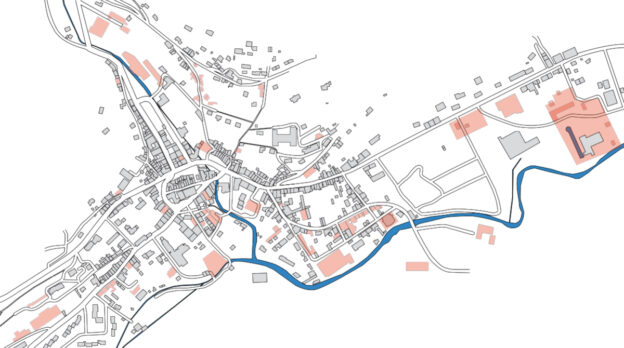
Élisabeth Ballet, Pilat Regional Nature Park
Situated in the Pilat Regional Nature Park near Saint-Etienne, the town of Bourg-Argental has retained the imprint of a textile activity developed there since the 16th century. Everything needed for textile production was in evidence – milling, warping, weaving, braiding, ribbon making; buildings linked to the industry made a strong mark on the landscape.
The project, initiated by the town of Bourg-Argental, is part of the Industrial Landscape programme unfolding in the four regional nature parks of Pilat, Monts-d’Ardèche, Lorraine and Vercors. Residents and elected officials wished to highlight the industrial past and make the conscious and unconscious traces of the textile industry legible. It is a question of addressing spaces created by the destruction of certain buildings in line with architecture still in existence.
Élisabeth Ballet initially conducted a meticulous investigation to collect data on weaving and ribbon making, but also to reread, spatially, Bourg-Argental’s industrial history. The places she identified could not be used (either inaccessible or decreed flooded, by the state), so in 2013, the commune invited her to invest in a central space that was the former site of the Jarrosson textile factory.
Élisabeth Ballet’s work takes shape in this space and goes beyond, including a trail that retraces the town’s textile activity, as well as a book.
- Jarrosson Square: finding a purpose.
The first thing to do is to clear the original factory space by removing everything that obstructs the square, and reveal the original gate and surrounding wall at the bottom of the garden. “Then the square will turn into a pedestrian agora, the garden part raised like a stage, opens onto the town and is visible to everyone.”
On the ground, granite paving will depict weaving in motion across its entire length, then continue past the route nationale, to suggest that weaving gave work to the whole town with some fifty factories and studios dedicated to textile.
- The trail through the town.
With the help of Mr. Michel Linossier, former weaving combs manufacturer, Élisabeth Ballet located a large section of the missing workshops street by street, and drew a map to guide the visitor on his/ her journey through the town. An enamelled sign serves as a landmark at each site.
- The Book
Because a physical artwork cannot reveal the work of research, Élisabeth Ballet wanted to produce a book to restore the profile of weaving spaces. “It will be divided into one part for drawing, another for the archives and interviews. I have collected instruction books, sample books and more technical archives on the practice of weaving….My objective is to show, through the progressions of words, a changing profession, through images, which is emblematic of places and practices in a factory that was witness.”
Patrons: The commune of Bourg-Argental, represented by mayor Stéphane Heyraud and deputy mayors.
Funding: Pilat Regional Nature Park, within the European LEADER programme (European Agricultural Fund for Rural Development), Fondation de France /New Patrons, the town of Bourg-Argental
In Progress
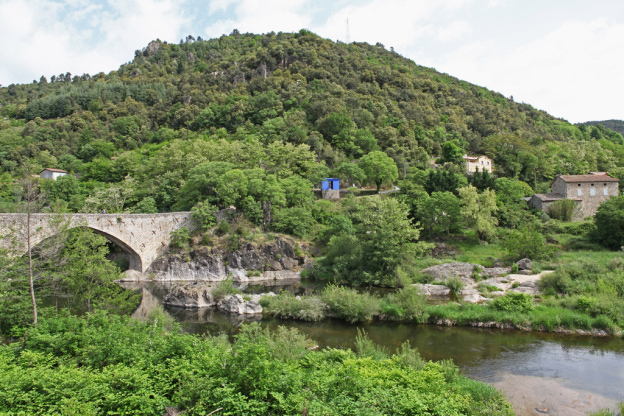
Élisabeth Ballet, Monts d’Ardèche Regional Nature Park
You Will Tell Me
You Will Tell Me is Élisabeth Ballet’s response to a commission awarded by elected officials and residents of the former Eyrieux-aux-Serres Community of Communes and the Monts d’Ardèche Regional Nature Park. Today this region, located in the middle range mountain zone, has more than twenty abandoned milling and weaving workshops and the question of their reclassification is recurrent. The Community of Communes wished to reflect on the presence and transformation of this industrial landscape and to address the social dimension of textile work.
In Saint-Sauveur-de-Montagut, the presence of the Moulinon on the banks of the River Eyrieux is strong evidence of local working history. Élisabeth Ballet created a “listening chamber” in the old station stop across the river opposite the old mill. This shelter is painted blue and is preceded by a terrace equipped with two red-brown concrete benches. Inside, a window fitted with a railing was broken open to offer a frontal view of the Moulinon. An audio montage is broadcast in various places to multiply listening points.
“The distance between the factory that we will admire and the site itself,” writes the artist, “will allow the creation of an intangible work.” In the listening chamber, the sounds of the river, the turbine and of nature mingle with noises of machines and voices of factory workers. “These voices invite us to take time to listen to stories of work accomplished here – its price, its joys and sorrows – and thus learn about the workers’ skills.”
Patrons: elected officials and residents of the former Eyrieux-aux-Serres Community of Communes and the Monts d’Ardèche Regional Nature Park.
Funding: Monts d’Ardèche Regional Nature Park as part of the European LEADER programme (European Agricultural Fund for Rural Development), Fondation de France / New Patrons, Rhône-Alpes Region, former Community of Communes Privas Centre Ardèche.
2014
Photographic credits: Phoebé Meyer
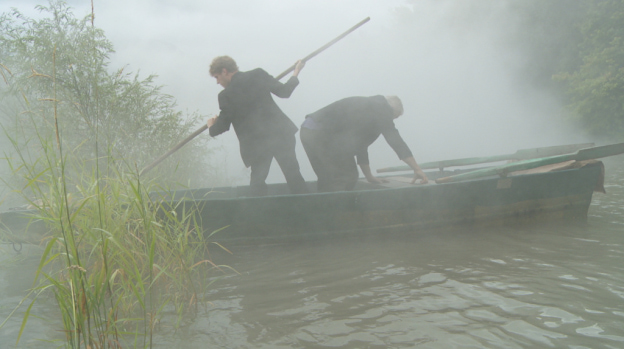
Susanne Bürner, Vercors Regional Nature Park
The Crossing
The Isère and the Work:
The communes on the left bank of the Isère river are situated within Grenoble’s urban expansion and on the historic route linking the Alps to the Mediterranean. Real estate pressure due to proximity to the Grenoble agglomeration and the grouping of communes into communities made these villages reposition themselves in order to preserve their specificities.
In the context of the region’s growing urbanisation, the old industrial sites are part of common imagination in connection with local working class history forged over several generations. Susanne Bürner was invited to take note of this observation. Two emblematic sites were located – the old royal Saint-Gervais canon foundry and the Echaillon quarries.
Susanne Bürner did not want to limit her research to the history of the two communes however, she immersed herself in local geography, visited many sites and collected stories as well as rich iconography on the industrial history of the two banks of the Isère. During the course of her reflections, the river’s role appeared strategic – it facilitated the circulation of goods, people and labour with bridges, boats, rafts and traps. Its strong presence at the foot of the Vercors hills always impresses the traveller. It is also through the eyes of a foreigner, in this case a young boatman, that Susanne Bürner presents fiction in the form of a film, The Crossing. The publication of two leperellos, L’Isère and Le Travail, (The Isère and The Work), combine images, archival drawings and the artist’s own photographs.
invitation, Decembre 2014 – pdf
La Traversée
L’Isère and Le Travail (The Isère and The Work)
Artist’s edition, 600 examples
Width of leperello when opened out: 104 x 10.4cm
10 euros for the set
Patrons: Saint-Gervais Commune represented by Madame Faure, the mayor, members of the SPIA association – Sauvegarde du patrimoine industriel d’autrefois (Safeguarding the Industrial Heritage of Yesteryear) and the Vercors Regional Nature Park
Funding: Vercors Regional Nature Park within the Framework of the European LEADER programme (Fonds européen agricole pour le Développement rural), Fondation de France / New Patrons Programme
Film credits: Susanne Bürner, photographic credits: édition Phoebé Meyer
2014
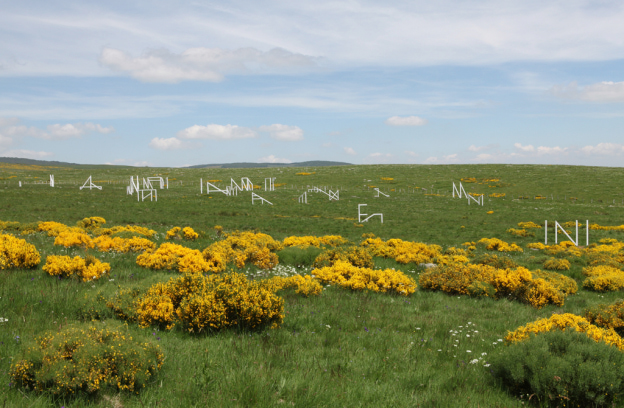
Camille Henrot in Pailherols, Cantal
My montagne
Since the height of Antiquity, the Cantal mountains have been part of farmers’ lives by providing them with summer pastures for their livestock. For four months, men aged between 12 and 70 watched over the herd and the quality of cheese produced in a grandiose landscape with a harsh climate. These cowherds or “buronniers” were masters of a pastoral economy that has now disappeared.
Farmer Jean-Paul Soubeyre, wanted to honour the memory of these buronniers who left a deep mark on the social and economic life of these lands known as summer pastures or transhumant. Convinced of the need to “make an act of recognition” for these men, the Pailherols Commune and the Sauvegarde des burons du Cantal association joined forces to support him with his project.
The artist Camille Henrot was invited to imagine a work that bears witness to a powerful human story and to the close link between man, animal and landscape. This contemporary work is neither a monument to the dead nor a folkloric endeavour, but a part of the universal history of pastoral farming.
At the entrance to the village, in an enclosed garden, Le Vestiaire du berger (The Shepherd’s Hut) marks a symbolic departure point for a trek up to the summer pastures. Forms suggestive of familiar objects recall the buronnier’s universe and work. The Vestiaire emphasizes the fact that these traditional objects are no longer in use, but also the possibility that this is only a temporary state. Then, like an invitation to roam, My Mountain spreads out along a hiking trail into the countryside. The artist created around forty sculptures inspired by the form of the fence or movable barrier used by the cowherds to corral their herds. Their forms reference the Trigrammes of I-Ching (The Book of Transformations), in which there are sixty-four combinations that describe the states of the world and their evolution. Here, in a confined space, the sculpture park appears as a constellation that recalls the universal contemplation of the starry heavens and sends us back to infinity. White in colour, the fences disappear into the snowy landscape in winter only to reappear again each spring.
Patrons: Association pour la sauvegarde des burons du Cantal and the Pailherols Commune.
Mediation/ production: Valérie Cudel and Mari Linnman for the New Patrons Programme initiated by Fondation de France.
Funding: Fondation de France (New Patrons Programme), Fondation Carasso, Minister of Culture and Communication under Public Commission in partnership with DRAC Auvergne Rhône Alpes, Pailherols Commune, Cantal Department, Cère and Goul Communauté de communes, Association pour la sauvegarde des burons du Cantal.
Inauguration: June 2016
Press release, June 2016
Photographic credits: Phoebé Meyer










































































